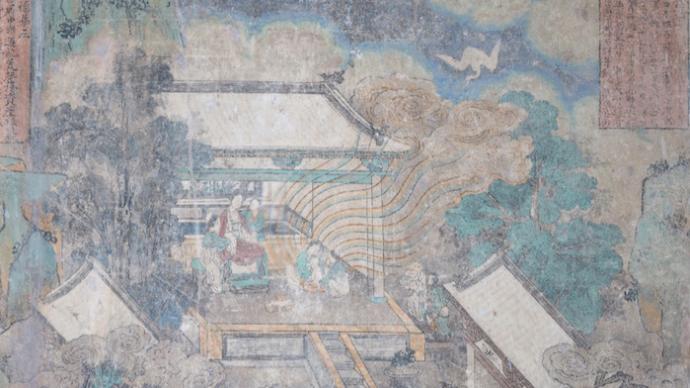
Yongle Palace was originally located in Yongle Town, Ruicheng, Shanxi Province, so it was called "Yongle Palace". On April 22, the salon event "House of the Gods, Images, Architecture and Space of Yongle Palace" was held at Suzhou Wu Culture Museum. Li Luke, a special researcher and doctoral supervisor of the School of Architecture of Tsinghua University, designed the architecture, murals and interior space of Yongle Palace. As the object, it talked about the construction process and spatial image of Yongle Palace. The Paper hereby organizes and publishes some of the content of the lecture.
images of buildings and images of buildings
"Zhou Li·Chunguan Zongbo" stipulates that the main work of "the priesthood" is " the residence of ghosts and gods " (this sentence is quoted in the (Song) "Building French Style" Volume 2 General Explanation, Color Paintings.), "It is still "It is imitation, drawing, "the residence of ghosts and gods" according to the commentary of the Tang Dynasty, it is " the sitting person of gods, men, ghosts and earth " ((Tang) Zheng Kangcheng. Commentary on Zhou Li [M]. Volume 27. Chunguan Zongbo·Shen Sergeant), can also be understood more broadly as "a place where ghosts and spirits stay or live".
![(Late Warring States Period) A tower-shaped square column unearthed in Yanxiadu, Yixian County, Hebei Province. A hollowed-out terrace was cast on the upper floor, and four people were seated on it. Image source (Complete Works of Chinese Bronze Ware[M] Vol. 9 Figure 139)](https://apollopic.nodefu.net/mfmpjthmbp4urawp58vjyuwt7weonb6w.jpg)
(Late Warring States Period) A tower-shaped square column unearthed in Yanxiadu, Yixian County, Hebei Province, with a hollowed-out terrace cast on the upper floor, and four people seated on the stage, picture source (Complete Works of Chinese Bronze Ware[M] Vol. 9, Figure 139)
The picture above is a tower-shaped square column in the late Warring States period unearthed in Yanxiadu, Yixian County, Hebei Province. The "flat seat" in the architectural images of the Warring States Period has clearly expressed the visual characteristics of protruding, open air, characters sitting on it, and covering the upper room, which is a vivid illustration of "the residence of ghosts and gods". Even though the faces of ghosts and gods in the images are blurred, they will be endowed with mysterious and majestic spiritual power due to the contrast of "equal sitting" and various other visual elements. This series of characters and scenes constitute the original historical elements of many ancient architectural places we see today.On this basis, we propose a concept of pictorial architecture, or architectural images that we often talk about, but in fact pictorial architecture is also a type of ancient architecture. We can say that "architectural images" refer to relics, such as paintings and utensils, which are mainly based on two-dimensional drawings or three-dimensional sculptures, which reproduce or express the image of the building, but do not have the space and function of the building. The term "image" is not limited to two-dimensional images in my opinion, but also includes three-dimensional objects. Specifically, “architectural images” generally refer to various forms of “reproducing” (reproduce) or “imitate” (imitate) the whole or part of the building by means of painting, sculpture, architectural decoration, etc., but the structure and function have been A 2D or 3D object that deviates from the characteristics of the original building feature. It can be said that "architectural images" no longer possess the original structural characteristics and functional functions of architectural elements, but become a symbolic medium.
![Schematic diagram of the space effect of the wall Tibetan and Xiaodouba caisson installed in the building's interior in "Building French Style", image source (Li Luke. The House of Gods - The Flat Sitting (balcony) in Chinese Architecture, Literature and Images [J].World Architecture) , 2020(10):24-29+137.)](https://apollopic.nodefu.net/u32pi6b6u06cbxsqyla5fk0395tjo20u.jpg)
Schematic diagram of the space effect of the wall Tibetan and Xiaodouba caisson installed in the interior of the building in "Building French Style", image source (Li Luke. The House of Gods - Flat Sitting (balcony) in Chinese Architecture, Documents and Images [J].World Architecture) , 2020(10):24-29+137.)
The image above is a schematic of how I use some architectural elements to spell out an image architectural space. This picture is a building in the Song and Liao Dynasty. The form of the palace comes from the Bhagha Temple of Huayan Temple in Datong. It is the survey drawing of Mr. Liang Sicheng in that year. There is a wall hidden in the interior of this temple. The wall storage is a kind of bookcase for collecting scriptures, but this bookcase is very special, it will be shaped into a building. This building was shrunk and placed in the normal building space. Since it is shrunk, it can add another architectural level on top, called Tiangong Pavilion. If worshippers walk into this architectural space, the first thing they will see is a very large building, and when they walk inside, they will see a very small building, which may contain statues and scriptures. The images of gods and Buddhas are slightly larger in real life. There will be caisson or ceilings above the heads of these images of gods and Buddhas to set off the atmosphere of the space. When a worshipper looks up, he sees a castle in the sky made of fine wood carvings. He would imagine that in the blissful world where the gods and Buddhas lived, there were wonderful and grand pavilions, and the gods and Buddhas each had their own place to live in it. This completes a spatial process from viewing to imagination.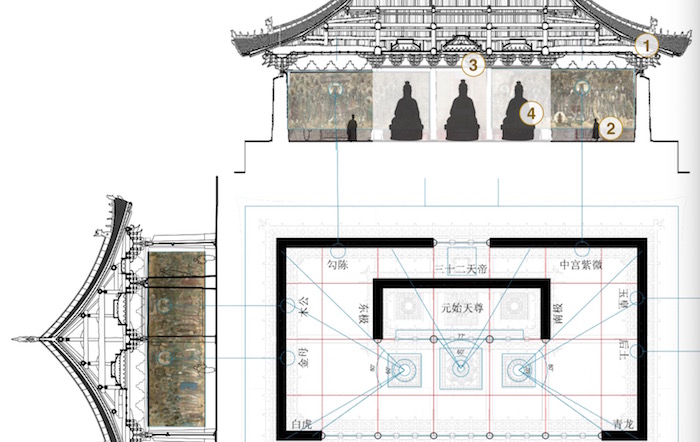
The interior layout of the Sanqing Hall of Yongle Palace
Specific to the case of Yongle Palace in Shanxi. For example, the interior space of the Sanqing Hall of Yongle Palace, the above picture shows the combination of the plane and interior facade of Yongle Palace, showing the building as a complex of visual art and living environment. The caisson and murals of Yongle Palace are not only part of the "real space" of the building, but also a fascinating "imaginary space" inside. It can be seen that there are at least four main elements in this space: the first element is the structural main body of the building, that is, the large wooden structure we are familiar with, including bucket arches, beams, columns, etc.; the second part is the interactive space, come to worship The people are also a part of the space; the third part is the interior miniature building, that is, the caisson above the heads of the gods, statues and worshipers. There are beams, columns and bucket arches in the caisson, but these structures are reduced to one-third to one-fifth of the normal structure; the fourth part is the protagonist of the interior space, which is actually the idol in the interior space, including sculptures The statues that come out also include the statues in the murals. It is a pity that the main statues in the Yongle Palace Hall have been missing. Together these parts form (in modern terms) an interactive spatial experience. This is a highly synthetic object. It is a spatial experience that combines architecture, murals and interior decoration.The Construction and Spatial Image of Yongle Palace
Yongle Palace was originally located in Yongle Town, Ruicheng, Shanxi Province, so it was called "Yongle Palace". Its founding history can be traced back to the end of the Tang Dynasty. It was originally the former residence of Lu Dongbin, one of the five ancestors of the Quanzhen School of Taoism. With the expansion of Taoism's influence, the temple of Lvgong was renovated and expanded, "taking the temple as the view"; since the reign of Genghis Khan, through the operation of Qiu Chuji, Yin Zhiping, Li Zhichang and others, the development of Quanzhen Taoism was influenced by the rulers of Mongolia and Yuan Dynasty. attention, and gradually reach its peak.
![The interior of Chongyang Hall: Comparison of photos in 1958 and 2019, the source of the picture (edited by Zha Qun, Preliminary compilation of the Yongle Palace Relocation Project Archives [M]. Beijing: Cultural Relics Publishing House, 2020.: Figures 3-132, 3-133)](https://apollopic.nodefu.net/yhlc8yrczydfduz9148cqhady1hxthj9.jpg)
Interior of Chongyang Palace: Comparison of photos in 1958 and 2019
Regarding the construction history of Yongle Palace, since the 1960s, there have been textual researches by scholars such as Su Bai, Jing Anning, Zhao Wei, etc. However, due to the discovery of new historical materials in recent years, we can understand the history of the construction of Yongle Palace more clearly stage, and the historical factors behind it. If, according to the views of Taoist historians such as Qing Xitai, the development of Quanzhen Taoism in the north during the Jin and Yuan Dynasties is divided into four periods: "founding", "peak", "low valley" and "guisheng", then the existing Yuan Dynasty in Yongle Palace The remains are just the important witnesses of the "Heyday" and "Guisheng" periods.About 1244, as one of the symbols of the prosperity of Quanzhen Sect, the more than 7,800 volumes of "Xuandu Daozang" were published and engraved by Song Defang. Just in the winter of 1244, the Lu Gong Temple, which was being renovated at the order of Song Defang, was destroyed by "wildfire". In 1245, taking this as an opportunity, Li Zhichang, the then headmaster of Quanzhen, asked for the "give palace forehead" for the "Hedong Yongle Chunyang Temple", and together with the retired former headmaster Yin Zhiping, he selected Pan Dechong to be the northeast of Hedong. Ludaomen mentioned points and presided over the reconstruction of Chunyang Palace. In 1250, the "Xuandu Taoist Collection" scripture board was entrusted to the Yongle Palace under construction for collection.
In the 12th year of Yuan to Yuan Dynasty (1275), it was also recorded in the "Guidelines for the Experience of Dao Zunzun": " Piyunzi Song Zhenren collected more than 7,800 Tibetan scriptures and put them in Yongle Town, Pingyang. It can be seen that the Yongle Palace has been called the "East Ancestral Court" when it collected scriptures, and it has a lofty position in the Quanzhen religion.
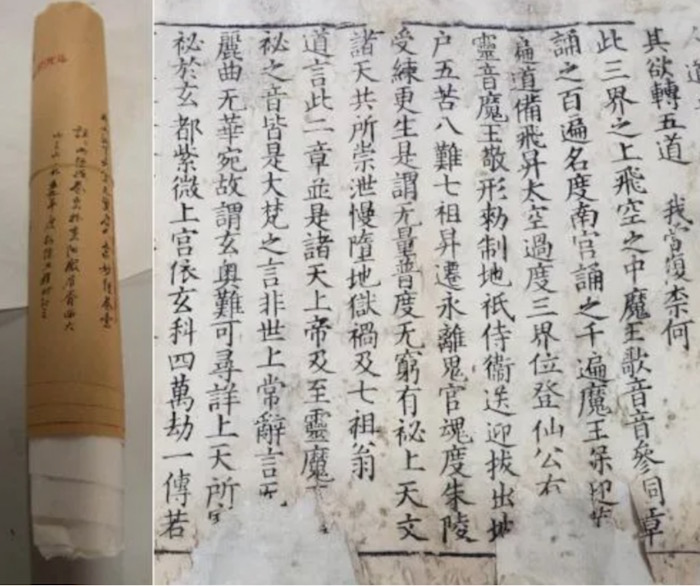
Document No. 6 recently cleared from the warehouse of Yongle Palace Mural Research Institute
Document No. 6 recently cleared from the warehouse of the Yongle Palace Mural Painting Research Institute is likely to be the second half volume of the "Salvation of Human Beings", the first volume of "Xuandu Taoist Collection" . among the beasts ". Records from the time of the Yongle Palace relocation project show that this scroll was discovered in 1959 in the West Bird Kiss of Chongyang Palace, and it may have been contained in a poplar scroll. Obviously, this scripture was buried in the owl kiss as a sacred relic with special significance before the completion of the Double Ninth Hall. This approach can also reflect the special connection between "Xuandu Daozang" and the construction of Yongle Palace.At the end of the Yuan Dynasty, Quanzhen sect experienced its second prosperity, and its political role had changed from "a counselor who manages the country and protects the people" to "a bureaucrat who sets up fast and prays for blessings". Yu Ji, an official active in this period, wrote an article describing how the Taoist temples at that time flourished and luxurious in the name of the emperor's birthday.

Comparison of old and new photos of the west owl kiss in Chongyang Palace
At this time, Yongle Palace, which has been named "Dachunyang Longevity Palace", is naturally also listed in the "Palace Building View" "for the emperor's longevity". The main project of its Wuji Gate, as well as the frescoes and It was after decades of stagnation that the interior decoration was completed in this "Guisheng" period. The inscription information can be proved including: In 1294, the Wuji Gate was built, and the Yuan Dynasty official Shang Ting wrote the plaque; 1320 In 1325, the murals of the Sanqing Hall were completed; in 1339, the ceiling of the Chunyang Hall was completed; In 1358, the murals of Chunyang Hall were completed.It should be noted here that the historical data we use is actually very limited. Although many important projects during the construction of Yongle Palace have erected steles, there are few words in these steles that directly explain the space and design ideas. We can put our vision into a larger scope of construction, and sort out the relevant Taoist literature and the description of spatial images. In this way, it can also be mutually verified with the existing physical objects of the palace of Yongle Palace.
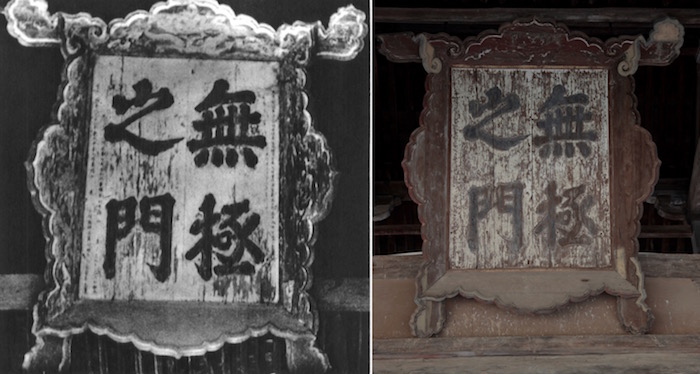
Comparison of old and new photos of Wujimen plaque
A grand Taoist temple like Yongle Palace was not the construction concept of Quanzhen Taoism at the beginning. During the period of Quanzhen Sect, the main way of practice was to cultivate introspection, and did not advocate large-scale construction of palaces. Wang Chongyang advocated that " the thatched hut in Maoan must cover the shape... Gou or carving Liang Junyu is not the act of a sergeant. Gaotang, is it the work of Taoists ?” Ma Yu more specifically stipulated that “there are no more than three rooms in the nunnery, and no more than three companions in the Taoist temple ”; when Zhiqiu Chuji was in charge, with the support of Jin Shizong, under the support of Jin Zhongdu’s “Jin Zhongdu” The statues of Chunyang, Chongyang, and Danyang, the founders of Quanzhen School, are in Guan'an. "The painted offerings are not well-prepared ." The current social status quo clearly regards " viewing and saving people" as the " priority of practice ". Pan Dechong, the host of the Yongle Palace, further developed the "Elephant Religion", advocating to expand the spread of religion with a specific image and a grand scale.There is an important exposition on the idea of creation in "The Stele of Pan Gong's Shinto": " As for the guest couples from all over the world, those who have visited the palace, Zhou Yuan looked around, and saw their strictness and grandeur, and the heart of respect was born spontaneously. If the ancestral hall is withdrawn and turned into a palace, the respect and inferiority will be separated from each other, and there will be thousands of people. However, in the true nature of pure yang, why increase the profit and loss? Therefore, the teaching of elephants cannot be abandoned to future generations. When the eyes and ears of the world are seen and heard, they must be free from blasphemy. Those who are strict with the outside are therefore supported by the inside. , the great and prosperous predestined relationship of the teacher, to make a new worship structure, how can it be just to boast of its grandeur! "
The idea of constructing this passage is to say: First of all, emphasize the importance of "perception" for communication: the magnificent and grand palace architecture is not closer to the "authenticity" of the spiritual teachings of the ancestors, but can be achieved through figurative forms of "image teaching". "And strengthen the "perception", so as to greatly enhance the power of religion to spread, to achieve the purpose of "going far"; then, "strict outside and inside": no longer use the traditional humble "shrine", but replace it with "palace court" ”, in the form and scale to pursue “strict and prosperous”, “stun the world’s eyes and ears”, and pursue the ultimate visual and auditory experience, so as to arouse the viewer’s “heart of respect” and put an end to the “heart of blasphemy”; finally, "Respecting the image and respecting the Tao": The purpose of "respecting the Tao" is achieved through the means of "respecting the image", so that the "Tao" can obtain a respected status. What needs to be added is that this passage is actually a description of Pan Dechong's disciple Liu Ruoshui after he completed the construction of the Chunyang Palace on Jiufeng Mountain. , should be bigger than Chunyang Shanggong.

Drawings of the Chongyang Temple surveyed and mapped by Tsinghua University in 1956
When the Yongle Palace was built, Pan Dechong had long since passed away. We don't know whether the effect created by Yongle Palace is the same as what he thought at the beginning, but we can see some impressions of later generations from some Ming and Qing historical materials. For example, in the description of "The Record of the Restoration of the Tablets of the Gods in Yongle Palace" in the late Ming Dynasty: "The scale is large, wide and wide, beautiful and magnificent, and magnificent. There are 360 statues of gods and gods on the wall, and there are more than 400 tablets. There are more than tens of zodiacs. The gods are splendid and brilliant, and the celestial beings are splendidly arranged, and the ceremonies of the year are celebrated, and the grand ceremony is completed. " We can see that this passage emphasizes the number of gods, and the grand occasion of memorial tablets and offerings at that time. In the early Qing Dynasty, "The Reconstruction of the Wanshou Palace in the Qing Dynasty" described the impression of the Yongle Palace after the reconstruction more comprehensively. The main body of the building and the color decoration are magnificent and full of vitality: "The building is lofty and the curtains are deep. The portrait in the hall is majestic and lifelike, and it is like being in a fairyland when looking at it: " Jinrong Ranran, the image is like an arch; the jade face is mumu, and the ring is beautiful. Qiongxi's light is bright, looking at it as if you are swimming in the sky, the luxuriant sea in the sea, and the blessed land in the world. "Let's take a look at what kind of space the Sanqing Palace was in people's imagination at that time. It is an ancient tradition to set up the Sanqing Hall in Taoist temples. Written before the early Tang Dynasty, "Sandong Feng Dao Ke Jie Ying Begins" clearly proposed that the form of Taoism should imitate the immortal world of heaven and become the embodiment of the immortal world in people's minds: " Fu Sanqing Shangjing, as well as the ten continents and five mountains, all Famous mountains, caves, and space are all governed by sages, or they are built into pavilions and palaces, or they gather clouds into a palace, or they live in the gates of the stars, sun and moon, or they live within the clouds and clouds, or they are naturalized. It may be created by divine power, or it may be repaired for many kalpas, or it may be established at one time. It may be Penglai, Abbot, Yuanqiao, Yingzhou, Pingpu, Langfeng, Kunlun, Xuanpu, or twelve jade buildings, three thousand golden towers, ten thousand There are thousands of names, which cannot be counted. They are all traces of the gods and gods. They are all sages and immortals. They are listed in various scriptures, and they will not be described in detail. They will make people look back to the sky, the wise and the foolish, and the wise and the ignorant. Lingguan is not only a blessed place, but also an immortal residence." "Sandong Fengdao Kejie Camp Begins" also collectively refers to the halls dedicated to the highest gods as "Tianzun Temple", and its shape can adopt "four annotations", that is, the roof of the temple. It can be as small as three rooms or as large as thirteen rooms. The architectural form can be very simple, or it can use expensive materials, ornate carvings and murals: " There are always six types of buildings in the construction of houses: one is called wood and spiritual materials, the other is produced according to the time, and the third is gold and jade carvings. The fourth is the structure of floating stones, the fifth is the painting of danqing, and the sixth is the soil steps of Maoci. ”
Since the Tang Dynasty, the setting of the "Sanqing Hall" has been very common in Taoist temples. In the early Ming Dynasty, Zhu Quan (Ning Wang) compiled the "Emperor to Dao Taiqing Jade Book" on the statues of the Sanqing Hall and the Jade Emperor Hall. The image configuration is specified in detail: " On both sides of the Sanqing Hall, the nine emperors and nine emperors should be statues. On both sides of the Jade Emperor Hall, the thirty-two emperors should be statues. On the walls of the second hall, the statues of the Yuan Dynasty of the Wansheng Dynasty should be painted. It can be seen that the image levels of the Three Qing Dynasty, the Nine Emperors, and the Wansheng Dynasty have become the stereotypes of the Sanqing Temple in the early Ming Dynasty.
It can be seen that the Chunyang Hall and the Chongyang Hall actually belong to the Patriarch Memorial Hall of the Quanzhen Sect. The portraits of Chunyang Patriarch and Chongyang Patriarch are based on real historical figures, usually in the background of various real space environments, depicting the life stories and "manifestation" deeds of saints.
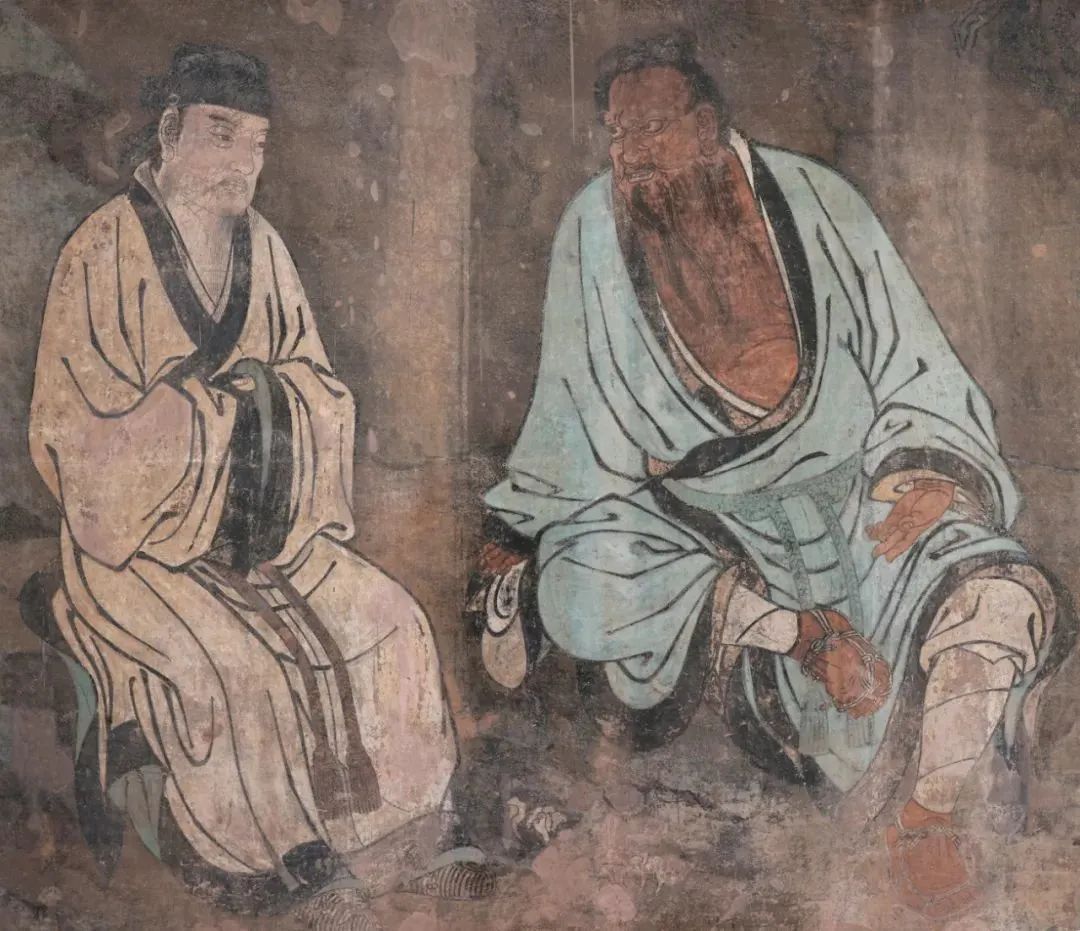
Chunyang Hall "Zhong Lu Talking about Taoism"
In the story of the Patriarch of Quanzhen Dao, the frescoes themselves also become a medium for "manifestation". The 40th edition of "Miaotongji of the Divine Transformation of Emperor Chunyang" records that Lv Dongbin once visited the Shenguang Temple in Shanyang, " beggar painted his own image in the Beitang of Sanqing Palace. His eyebrows were trimmed, his appearance was strange, and he was not like the world. There are The Seven Stars of the Big Dipper, the phase was sent, and Binggui stood beside him. " He drew a giant talisman with a length of more than one zhang next to it, which has the effect of curing diseases for the believers. This is in the form of portraits, listing himself among the gods, and by drawing talismans, he provides the grace of "healing", so as to win the admiration of the people.In the story of Patriarch Chunyang, there is also the use of murals to help others. For example, in the third volume of "Lu Zuzhi", there is a story of "Zhaozhou Medical Lameness". The Taoist helped each other, and after he recovered, he arranged to meet again on the left wall of the third room of the east corridor of the Yuntang in the east of the city. Liu went here as scheduled, and saw that there was a statue of a Dongbin on the wall carrying a scoop, which showed that it was the ancestor of Chunyang. Murals appear to save people. So here are some real features of the patriarch portrait.
Yongle Palace Architecture, Decorative Integrity and Graphics
Let's talk about how Yongle Palace reflects the construction idea in the architectural layout, architectural structure, architectural decoration and murals.
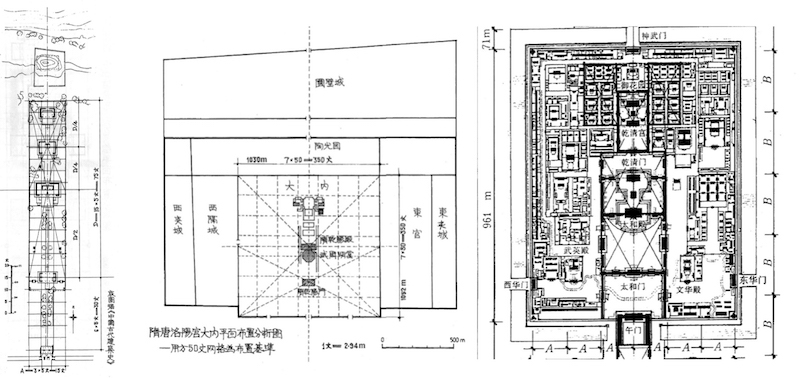
(Left) The floor plan of the surveying and mapping before the relocation of Yongle Palace, (middle) The plan ratio of Luoyang Palace in Sui and Tang Dynasties and (right) Forbidden City in Ming and Qing Dynasties
The above picture is the general plan scale analysis diagram of Yongle Palace before the relocation: the courtyard size is planned with a 5-zhang grid; the front hall (Sanqing Hall) is located in the geometric center of the main hall and the Wujimen courtyard, and the middle hall (Chunyang Hall) is located in the front hall The geometric center of the area after. Such a layout means that the front yard is particularly open and the back yard is relatively compact, which is different from the living space of ordinary people. Looking at the palaces of the past dynasties, you will see that both the palaces of the Sui and Tang dynasties and the palaces of the Ming and Qing dynasties have the characteristic that the front hall is arranged in the geometric center of the main area of the palace. This in turn shows that the spatial geometric relationship between the several halls of Yongle Palace is configured with reference to the layout of ancient palaces.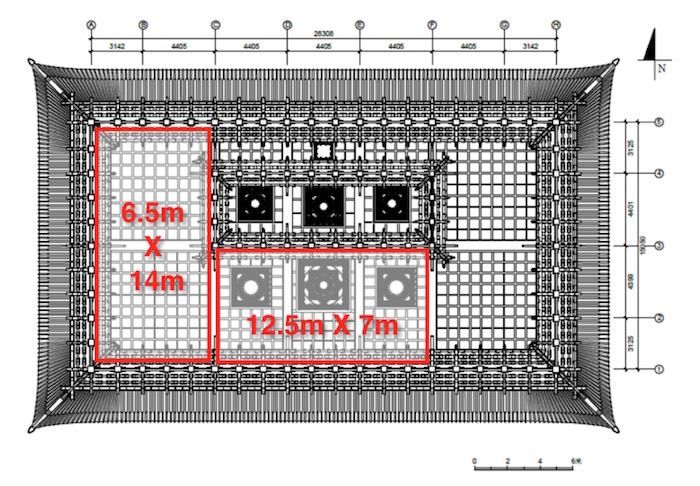
The ceiling view of the Sanqing Hall of Yongle Palace (Tsinghua University Surveying and Mapping in 2018)
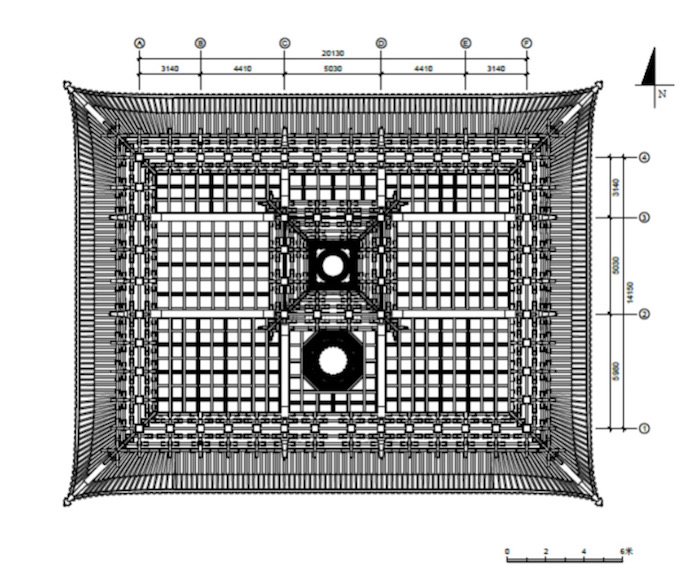
Looking up plane of the ceiling of Chunyang Hall of Yongle Palace (Tsinghua University Surveying and Mapping in 2019)
Then we will look at the relationship between architectural structure, architectural caisson and murals. The picture above is a detailed survey and mapping of the Sanqing Hall and Chunyang Hall of Yongle Palace between 2018 and 2019, and the bottom view of the ceiling drawn.We can see some connections between the large wooden structure of the temple and the ceiling. Taking Sanqingdian as an example, a relatively wide space is formed in its front and side. Its overall space is actually divided into two layers, the inner and outer layers. There is a circle of bucket arches called the outer groove, which encloses the inner space of the entire palace. There is a circle of bucket arches in the inner space of the hall, enclosing a more secret space. Sanqing Hall has a very different situation from other buildings, that is, its outer and inner grooves have caisson. The caisson in the inner groove is for gods and Buddhas, so who is the caisson in the outer groove for? Obviously it is for those who come to worship the Buddha statue. Why do people who come to worship Buddha statues get such a revered status? Because Yongle Palace has a very special status, that is, praying for blessing and prolonging the life of the emperor of the Yuan Dynasty. Therefore, you will see that in the Sanqing Hall of Yongle Palace, the complexity, gorgeousness and scale of the caisson in front of it even exceed those of the inner slot caisson. This is the special point of the Sanqing Hall of Yongle Palace.
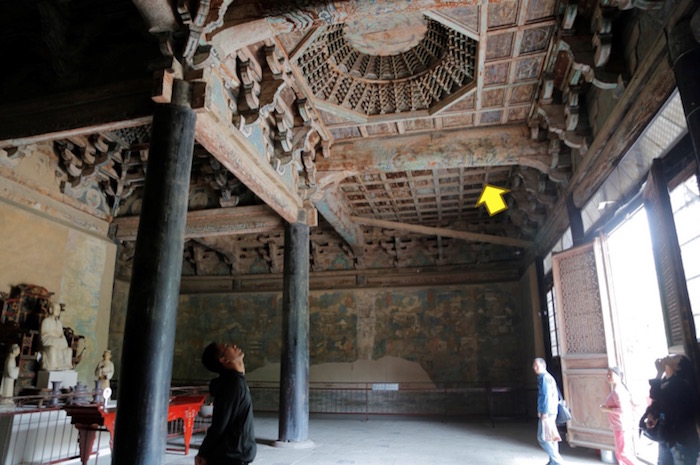
Shanxi Ruicheng Yongle Palace Chunyang Hall
We made a scientific record of the colors and decorations of Yongle Palace, systematically collected the chromaticity data of Yongle Palace's frescoes and color paintings, and made some statistical analysis on these chromaticity data. At the same time, through a large number of photos taken and organized, the color painting patterns on the surface of the wooden structure of Yongle Palace were further identified, and the color painting patterns were also meticulously organized and color restored, and some three-dimensional components were also color restored.
Ornament survey
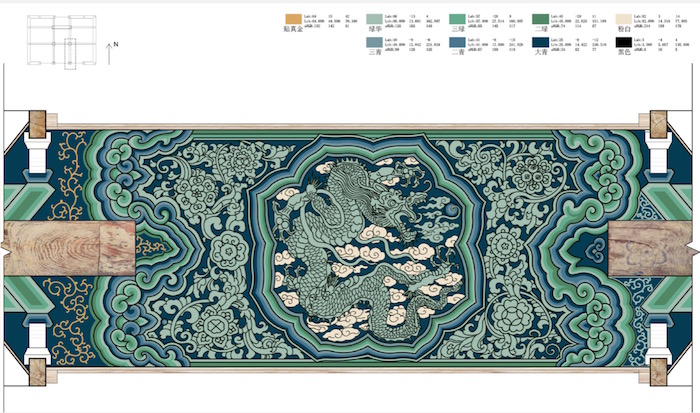
Restoration mapping and multi-scheme comparison
Regarding some other spatial elements inside Yongle Palace, such as the colored paintings on the surface of the wooden structure of the building. We found that there are four different types of colored paintings on the surface of the wooden structure in Sanqing Hall. There are simple and cumbersome differences between these four types, and the closer to the middle of the front groove, the more complex it is (but it is slightly asymmetrical to the left and right). The same situation exists in the Hall of Pure Sun. That is, the more complex it is, the more it will be used on this part of the building that has a larger scale and a more central location.
Panoramic image of Sanqing Palace
As shown in the panoramic image, if you walk into the interior of the Sanqing Hall, you will feel a relatively large outer trough with a width of more than 6 meters. On the frescoes, the direction of sight of each god statue is not exactly the same, but there is a general direction that attracts you to move forward, until you reach the back slot of the building, you will also see the God of Savior. From this, we can see very briefly how the architecture and images of Yongle Palace express the overall spatial intention.
The city in the mural
Finally, let's talk about the architectural image of Yongle Palace. The murals in Chunyang Hall and Chongyang Hall of Yongle Palace are mainly based on the stories of the two ancestors, but a large number of architectural images are also added. The practice of drawing a large number of architectural images into murals has begun to rise in the Sui and Tang Dynasties. In the Song Dynasty, the depiction of buildings in Chinese painting formed a specialization (called "house wood", "palace room", "boundary painting", etc.) and developed to a peak, and the Yuan Dynasty was a continuation of this peak. The painting techniques of this period have reached a high level in the expression of the "objective image" of architecture, which can be used as a representative of the characteristics of architectural images. In short, for some works, it is indeed possible to infer the architectural practices and even the proportions of the buildings at that time from the images.The architectural images in the Yongle Palace murals are highly realistic. The images depict a large number of details that are consistent with the actual practices in terms of group structure, single shape and details, including the city, including the pagoda, including residential courtyards, gardens, Gardens, pavilions, dojos, etc.

"Rui Ying Yongle"
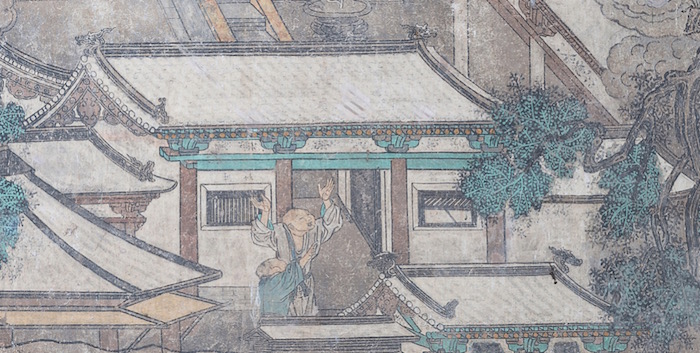
"Rui Ying Yongle" (detail)
Take the first painting "Rui Ying Yongle" on the east wall of Chunyang Hall as an example. This painting is about the scene of Lv Dongbin's birth. The time and place was in the Lv family residence in Yongle County in the late Tang Dynasty. Therefore, this painting represents the residence of a large family at that time, and there is an inscription in the upper right corner. The overall layout of this painting: two entrances into the courtyard, the central axis is followed by a single-bay door house, a three-bay passing hall (or a second door), and the main hall, surrounded by courtyard walls. There is a square pavilion with four corners on the west side of the front yard, and there are wing rooms on both sides of the back yard. There are flowers and bonsai in the courtyard, and trees, clouds and rocks outside the courtyard, which are separated from other scenes.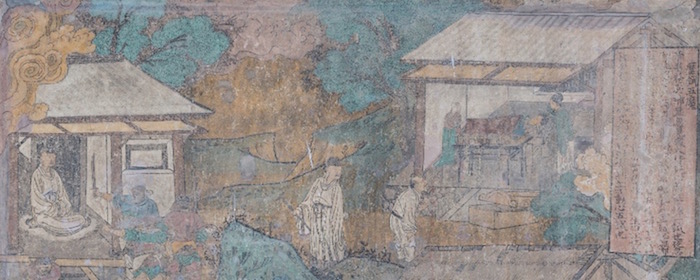
"Huang Liang Dream"
In addition, another mural "Huangliang Mengjue" tells the story of Lu Dongbin going to Chang'an to take the exam when he was 21 years old and meeting his teacher Han Zhongli. It can be seen from this that the form and level of the house in the painting are obviously lower than those of the noble residence in "Rui Ying Yongle", and the color of the building has not been modified more. In these stories, some very appropriate architectural formations are used as backdrops for the characters of the stories. These architectural forms not only suggest the identity of the characters, but also provide an appropriate stage for the activities of the characters, so that the viewer can get an immersive feeling through these details.So far, from the overall courtyard layout of Yongle Palace to its architectural structure, to the color paintings and murals in it, we can roughly understand how these different parts collectively express the idea of creation.